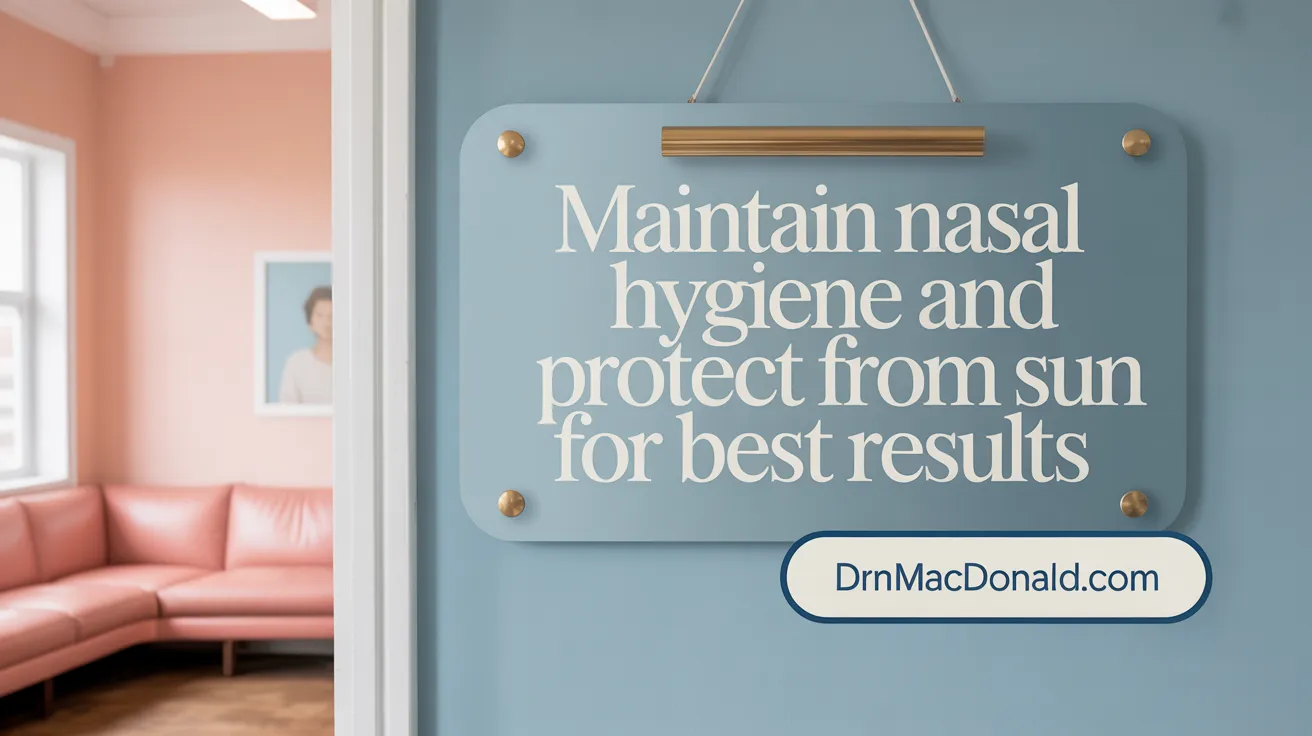Introduction to Rhinoplasty Recovery
Rhinoplasty, commonly known as a nose job, is a delicate surgical procedure aimed at improving the nose's appearance and functionality. Post-operative recovery plays a crucial role in achieving optimal and lasting results. This article provides comprehensive guidance on post-op care, typical healing stages, risk management, and practical tips to ensure a smooth rhinoplasty recovery. Understanding what to expect and how to care for your nose helps patients navigate this journey safely and with realistic expectations.
Facilitating a Smooth Recovery: Key Post-Operative Practices

How can one facilitate a smooth recovery after rhinoplasty?
To promote optimal healing after rhinoplasty, patients should adhere strictly to their surgeon’s post-operative instructions. This includes diligent wound care, taking prescribed medications on schedule, and maintaining good hygiene. Elevated head positioning—using pillows or a recliner—helps reduce swelling and bruising, which generally improves within the first few weeks (head elevation after rhinoplasty, rest and head elevation after rhinoplasty).
Applying cold packs or ice carefully to the cheeks and around the eyes can significantly decrease swelling and discomfort (using cold compresses after surgery). It’s crucial to avoid strenuous activities, heavy lifting, or vigorous facial movements during the initial recovery period, typically the first two to three weeks (exercise restrictions after rhinoplasty, activity restrictions post-rhinoplasty).
Patients should refrain from blowing or rubbing the nose for at least one week (avoiding nose blowing after rhinoplasty), and should avoid wearing glasses directly on the nose until cleared by their surgeon, which can often be around four to six weeks (glasses and rhinoplasty healing). Protecting the nose from the sun by using sunscreen or wearing a hat with a brim prevents scarring darkening and swelling increase (sun protection after rhinoplasty).
Smoking impairs blood flow and delays healing; cessation before and after surgery is strongly recommended (smoking cessation and healing). Maintaining hydration, consuming a nutritious diet rich in vitamins A and C (healthy diet for rhinoplasty recovery), and avoiding hot foods or environments also support faster recovery (avoiding heat and steam after surgery).
Regular follow-up visits allow healthcare providers to monitor healing, address any concerns promptly, and manage complications early (follow-up care after rhinoplasty). Prompt communication about any signs of infection, bleeding, or unusual symptoms is vital for ensuring a smooth recovery (signs of complications after rhinoplasty).
Overall, patience, adherence to medical advice, and proper self-care are essential components in achieving the best surgical outcome and a seamless healing process (patience during rhinoplasty recovery).
Post-Operative Care Instructions and Best Practices After Rhinoplasty

What post-operative care instructions and best practices are generally recommended for rhinoplasty recovery?
After rhinoplasty, proper care significantly impacts healing and final outcomes. Patients are advised to maintain excellent nasal hygiene and wound care to prevent infection and promote healing. Gentle cleaning of the incision sites with hydrogen peroxide and Q-tips, and applying Vaseline to keep incisions moist, are common practices (Hormonal Care After Nasal Surgery, Nasal Care after Rhinoplasty).
Sleeping positions play an important role in reducing swelling; patients should sleep on their back with their head elevated on two to three pillows or in a recliner for at least one week. This elevation helps reduce swelling and minimizes pressure on the nose (Sleeping position after rhinoplasty, Sleeping elevated after rhinoplasty).
To manage swelling and discomfort, cold compresses or gel packs should be applied around the eyes and cheeks during the first four days, avoiding direct contact with the nose. Applying ice in intervals of 20 minutes every 1-2 hours helps diminish bruising and swelling (Cold compresses for swelling, Using cold compresses post-surgery).
Patients should avoid strenuous activities, heavy lifting, and bending forward for at least two to three weeks. Engaging in gentle walking can enhance circulation but should be done within personal comfort limits (Exercise restrictions after rhinoplasty, Postoperative restrictions).
Medications prescribed by the surgeon, such as pain relievers, antibiotics, and steroids, should be taken as directed. Saline nasal sprays can be used daily to prevent dryness and congestion, starting after the first 24 hours (Medication and incision care instructions, Saline nasal spray instructions).
Wearing glasses that rest on the nose is discouraged for several weeks; instead, patients should use alternative options like contacts or tape glasses to the forehead as recommended (Glasses and rhinoplasty healing, Glasses wearing precautions).
Follow-up visits are crucial for monitoring healing, and patients should adhere to all specific instructions regarding splint and packing removal, incision care, and activity restrictions (Follow-up care after rhinoplasty, Post-rhinoplasty care instructions).
In summary, maintaining nasal hygiene, protecting the nose from sun exposure, elevating the head during sleep, avoiding pressure on the nose, and following medication guidelines are essential steps in ensuring a smooth recovery and optimal results (Sun protection after rhinoplasty, Postoperative care for rhinoplasty).
Understanding the Rhinoplasty Healing Timeline and Stages

Immediate post-op phase
Following rhinoplasty, patients typically experience swelling, bruising, nasal congestion, and mild discomfort. During the first 48 hours, swelling and bruising are most prominent, particularly around the eyes. A nasal splint is usually in place to support the new shape of the nose during this initial period. Applying cold compresses can help reduce swelling, but they should not be applied directly to the nose.
Swelling and bruising progression
Swelling peaks within the first two to three days and then gradually begins to decrease. Most patients notice a significant reduction in swelling and bruising within the first two weeks, with about 70-80% of swelling subsiding during this time. Bruising around the eyes also lessens, and many individuals can return to work or light activities after about a week.
Return to normal activities timeline
By approximately 3-4 weeks, the majority of swelling and bruising has diminished, and patients can resume most daily activities and gentle exercise. Strenuous activities, heavy lifting, and contact sports are generally avoided for at least 3-6 weeks to permit adequate healing of the nasal bones and tissues. Glasses that rest on the nose should be avoided for about 4-6 weeks unless specifically approved by the surgeon.
Long-term healing and refinement
Although initial improvements are visible after the first month, subtle changes and residual swelling can continue to resolve over several months. The nasal bridge and shape often become more refined between 3 and 6 months post-surgery. Internal healing, including the resolution of swelling inside the nasal tissues, can take up to 12 months, with the final shape and aesthetic results fully settling by this time. For further details, see the full rhinoplasty recovery timeline.
Patient patience and expectation management
Patience is vital during this lengthy process. It is normal for some swelling and minor irregularities to persist for many months. Full results—where the nose appears natural and stable—are typically seen around one year after surgery. Maintaining realistic expectations and following all post-operative care instructions contribute to an optimal outcome, allowing the nose to heal perfectly and ensuring satisfaction with the final appearance.
For more detailed information about rhinoplasty recovery stages and timeline, consult your surgeon or reliable medical resources dedicated to post-surgical healing.
Managing Swelling, Pain, and Discomfort Effectively
 Effective management of swelling, pain, and discomfort during rhinoplasty recovery involves several key strategies. In the initial days after surgery, applying cold compresses is highly recommended. Use a cold pack or gel pack wrapped in a cloth and place it gently over the cheeks and around the eyes—avoiding direct contact with the nose—to help reduce swelling, bruising, and numbness. This treatment is most effective during the first 72 hours.
Effective management of swelling, pain, and discomfort during rhinoplasty recovery involves several key strategies. In the initial days after surgery, applying cold compresses is highly recommended. Use a cold pack or gel pack wrapped in a cloth and place it gently over the cheeks and around the eyes—avoiding direct contact with the nose—to help reduce swelling, bruising, and numbness. This treatment is most effective during the first 72 hours.
Keeping the head elevated at all times, especially while sleeping, promotes drainage of fluids and minimizes swelling. Surgeons often advise patients to sleep on their back with their head propped up on two or three pillows or in a recliner, ideally for at least six weeks (Sleeping position after rhinoplasty).
Pain medications prescribed by the surgeon, such as acetaminophen or mild analgesics, should be taken as directed. These medicines help alleviate discomfort without interfering with the healing process. If pain becomes severe or unmanageable, patients should contact their healthcare provider immediately (Pain management after rhinoplasty).
Avoiding strenuous activities and facial movements significantly benefits recovery. Patients should refrain from heavy lifting, vigorous exercise, and actions like blowing the nose or sneezing forcefully, as these can increase swelling and disrupt healing tissues. Instead, sneezing should be done through the open mouth to avoid pressure (Avoiding nose blowing and sneezing techniques).
Proper diet and hydration also contribute to a smoother recovery. Consuming foods rich in protein and vitamins A and C supports tissue repair and reduces inflammation. Staying well-hydrated by drinking plenty of fluids, while limiting salt intake, helps further diminish swelling (Healthy diet for rhinoplasty recovery).
Lastly, strictly adhering to your surgeon’s instructions regarding wound care, activity restrictions, follow-up appointments, and precautions is essential for safe and effective healing (Postoperative care for rhinoplasty). Patience is important, as swelling and bruising can take several weeks to months to resolve fully, revealing the final aesthetic result (Patience during rhinoplasty recovery).
Optimal Sleep Positions and Head Elevation to Support Healing
 For optimal rhinoplasty recovery, it is recommended to sleep on your back with your head elevated at a 30- to 45-degree angle. Using multiple pillows or a reclined chair can help maintain this elevation throughout the night. This position effectively reduces swelling, congestion, and fluid retention around the nose, which are common concerns in the early healing phase.
For optimal rhinoplasty recovery, it is recommended to sleep on your back with your head elevated at a 30- to 45-degree angle. Using multiple pillows or a reclined chair can help maintain this elevation throughout the night. This position effectively reduces swelling, congestion, and fluid retention around the nose, which are common concerns in the early healing phase.
Patients are advised to keep this elevated sleep position for at least one to two weeks, and many surgeons suggest extending this to 10-14 days to maximize swelling reduction. During this period, avoiding sleeping on the stomach or sides is crucial, as these positions can put unwanted pressure on the delicate surgical area, potentially leading to swelling, shifts in nasal structures, or even inadvertent injury.
Supportive pillows, like travel or neck pillows, can prevent rolling over during sleep, ensuring continuous elevation. Sleeping separately from pets or partners can also reduce accidental bumps that might disrupt healing.
Adherence to these positional practices, combined with following your surgeon’s specific post-operative instructions, will help facilitate proper healing and improve overall results. Protecting your nose during sleep not only minimizes physical trauma but also promotes a more comfortable recovery experience.
Diet, Activities, and Precautions for Post-Surgical Care
During rhinoplasty recovery timeline, maintaining proper diet, activity levels, and precautions is essential for optimal healing. Initially, patients should focus on a soft, bland, and nutritious diet, including items such as yogurt, mashed potatoes, scrambled eggs, and fruits like strawberries and watermelon. These foods are easy to chew and gentle on the nasal area, helping to minimize discomfort and swelling. See Rhinoplasty aftercare diet for more information.
Staying well-hydrated is equally important. Drinking plenty of fluids, specifically cool and non-carbonated beverages, supports tissue healing and helps reduce swelling. It’s advisable to avoid alcohol and caffeine, as these can dehydrate the body and impede recovery. Additionally, avoiding spicy foods is recommended because they can irritate the nasal passages and lead to increased swelling.
Patients are advised to avoid medications that thin the blood, such as aspirin or ibuprofen, unless approved by their surgeon. Proper medication adherence, including completing prescribed antibiotics and pain management drugs, promotes infection prevention and comfort. Refer to Rhinoplasty post-operative care for medication instructions.
In terms of activity restrictions, patients should keep their head elevated at about 45 degrees during sleep, often using extra pillows or a recliner, for at least one to two weeks. This position reduces swelling and prevents displacement of nasal structures. Strenuous activities, heavy lifting, bending over, and vigorous exercise should be avoided for a minimum of 2 to 3 weeks, gradually resuming as tolerated and as advised by the surgeon. For detailed advice, see Rest and elevation after nose surgery and Exercise restrictions after rhinoplasty.
Wearing glasses or goggles that rest on the nose should be avoided for at least one month to prevent undue pressure on healing bones and cartilage. Alternative methods include tape or suspension techniques to prevent pressure damage; see Glasses and rhinoplasty healing for precautions.
Lastly, maintaining good nasal hygiene, like gentle saline rinses, following incision care instructions, and attending follow-up appointments are vital components of post-operative care. These practices minimize complications and support a smooth healing process, ensuring the best possible aesthetic and functional outcomes. For more on this, consult Nose care tips post-rhinoplasty and Postoperative care for rhinoplasty.
Recognizing Complications and Knowing When to Seek Medical Care
What common complications might occur after rhinoplasty, and how can they be recognized?
Common issues following rhinoplasty include infection, bleeding, and aesthetic or functional deformities. Infection signs involve persistent fever, increasing redness, swelling, warmth, or pus at the surgical site. Bleeding, especially if heavy or uncontrollable, often presents as steady blood flow requiring urgent attention. Aesthetic deformities such as the 'pollybeak', nasal asymmetry, or irregularities may be noticeable as uneven contours or deformities. Functional problems, including difficulty breathing, nasal blockages, or airway obstruction, may manifest as persistent congestion or labored breathing. Scarring at the incision sites, especially in open rhinoplasty, can sometimes be visible. Recognizing these signs early involves monitoring for ongoing pain, unusual nasal discharge, skin discoloration, or asymmetrical nasal appearance. Serious systemic risks like septicemia or toxic shock are rare but require immediate medical intervention. Early intraoperative issues such as mucoperichondrial tears, damage to bony or cartilaginous structures, or dislocation of implants should also be evaluated promptly. Prompt recognition and consultation with the surgeon facilitate effective management of these possible complications. For more detailed information on rhinoplasty complications and how to recognize them, see Rhinoplasty risks and complications and Common rhinoplasty complications.
When should a patient contact their healthcare provider regarding post-operative issues following rhinoplasty?
Patients are advised to contact their healthcare provider immediately if they experience severe or uncontrollable bleeding, difficulty breathing, or sudden worsening of nasal congestion. Persistent or worsening pain that is not relieved by prescribed medications, or signs of infection such as fever, redness, or pus, also warrant urgent medical attention. Any sudden changes in nose appearance, asymmetry, or swelling that does not improve can indicate a complication needing prompt evaluation. Awareness of symptoms like numbness, unusual skin sensations, or discoloration can help identify nerve or skin issues. If there are concerns about nasal patency or if there is excessive swelling and bruising that seem disproportionate or do not improve within the expected timeframe, timely consultation is essential. Routine follow-up appointments are scheduled to monitor healing progress, but urgent contact is crucial when symptoms suggest complications. Early intervention often prevents more serious outcomes and supports better recovery. Remember, while some discomfort and swelling are normal, the severity and persistence of symptoms should guide the decision to seek immediate care. For guidance on when to contact your surgeon or healthcare provider after rhinoplasty, refer to When to seek emergency care after rhinoplasty and Post-rhinoplasty warning signs.
Conclusion: Patience and Care Lead to Lasting Results
Recovering from rhinoplasty is a gradual and delicate process that requires patient adherence to post-operative instructions, cautious lifestyle adjustments, and close communication with healthcare providers. By maintaining proper wound care, avoiding activities or behaviors that increase risk, protecting the nose during sleep, and managing swelling and discomfort effectively, patients can optimize healing and minimize complications. Understanding the healing timeline and keeping realistic expectations about the gradual refinement of results helps reduce anxiety during recovery. With time, dedication to these care strategies, and the support of an experienced surgeon, most patients achieve the aesthetic and functional outcomes they desire, enjoying lasting benefits from their rhinoplasty.
